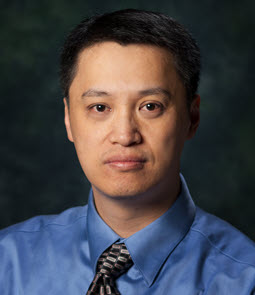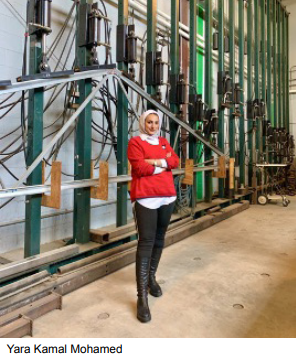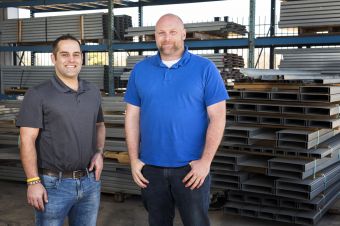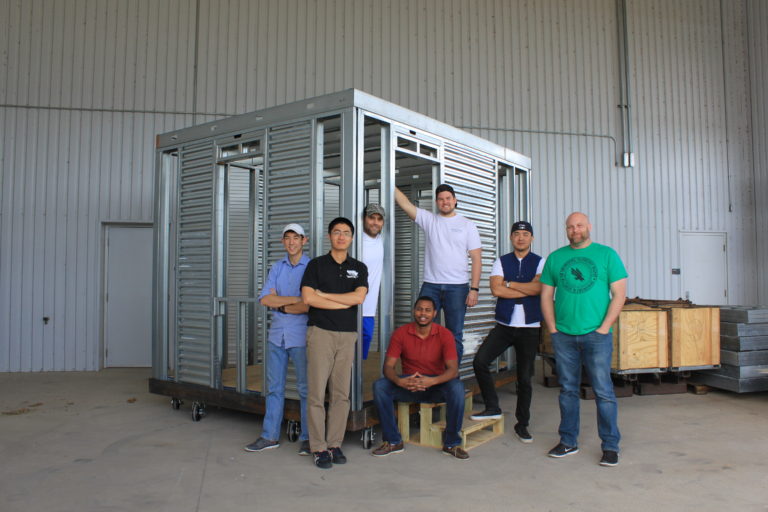Dr. Yu's group will make presentations at the 2017 CFSEI EXPO, Fort Worth, TX, May 22 and 23, 2017. http://www.cfsei.org/2017cfseiannualexpo
On May 21, a pre-conference tour will take place at Dr. Yu's CFS Lab on UNT's Discovery Park campus.
Once again, Professor Cheng Yu of University of North Texas is among the WORLD’S TOP 2% SCIENTISTS List published by STANFORD UNIVERSITY in 2024.

Cheng Yu, Ph.D., P.E., F.SEI, F.ASCE, a professor in the department of mechanical engineering at the University of North Texas, has been named a fellow by the ASCE Board of Direction.
As one of UNT’s founding faculty members, Yu has served as the program coordinator of the construction engineering technology program since 2005 and of the construction management program since 2022.
Read the whole article on ASCE website.
Once again, Professor Cheng Yu of University of North Texas is among the WORLD’S TOP 2% SCIENTISTS List published by STANFORD UNIVERSITY in 2023.
https://research.unt.edu/news/unt-experts-ranked-among-worlds-most-cited-2023
https://ecebm.com/2023/10/04/stanford-university-names-worlds-top-2-scientists-2023/
J-1 SPOTLIGHT: Our J-1 spotlight this Spring is on a visiting scholar from Egypt in the Structural Lab at UNT.
Meet visiting scholar Yara Kamal Mohamed Ismail from Egypt! Yara is a short-term visiting scholar from Egypt sponsored by USAID. She is spending her Spring 2023 semester under the tutelage of Dr. Cheng Yu from the Department of Mechanical Engineering. Yara’s academic work is focused on construction projects and cold-formed steel design within the field of mechanical engineering. Her research interests include developing a new approach in the design optimization of light gauge steel buildings that will allow people to enjoy a higher standard of living at a relatively lower cost. Yara chose to come to UNT as an exchange visitor because of Dr. Cheng Yu’s expertise in cold-formed steel design. She has learned a great deal from Dr. Yu during her short time at UNT and hopes to use the scientific knowledge that she has gained from this experience to enhance international collaboration in the field of construction engineering. Yara has enjoyed all the activities and resources at Discovery Park and the main campus. Outside of school and work, she loves to travel, watch movies, and exercise. She also likes to engage with her community by volunteering and doing charitable work. Be sure to greet Yara and give her a Mean Green high-five if you see her on campus!

RP20-8: Investigation of Bolted Connections in Cold-Formed Steel Members Using SAE J429 Bolts
by Babak Yeganeh, Graduate Student; Cheng Yu, Faculty Advisor
The research compared ASTM and J429 bolt standards in terms of tensile strength, chemical and mechanical properties, shanks length, head size, thread profile and bolt styles.
free download at
https://buildusingsteel.org/wp-content/uploads/2020/12/CFSD-Report-RP20-8.pdf
Going back to school after more than a decade isn’t easy — but it’s easier when you have support.
Babak Yeganeh and Aida Ashkan, a married couple and parents of an elementary-age son, entered UNT’s master’s in construction management program together. Now, they’re graduating together.
“Going back to school 17 years after I got my bachelor’s degree was a big challenge,” Yeganeh says. “Everything changed. It was a new university and a new program. My wife was part of my success. She helped me in my courses. We both worked in the construction labs and studied together.”
Immigrants from Tehran, Iran, where they both earned their bachelor’s degrees, Yeganeh and Ashkan had experience in construction and wanted to learn more about the industry and increase their opportunities in construction management. They chose UNT’s engineering technology program due to its reputation and that of its faculty.
“Dr. Yu, our major advisor, is the pioneer in cold-form steel structure,” Yeganeh says. “His lab is one of the most-equipped labs for testing construction material.”
They also describe Cheng Yu, professor and coordinator of the construction engineering technology program, and Seifollah Nasrazadani, professor and department chair, as instructors who made a real difference in their lives.
“Dr. Nasrazadani is my role model in many aspects of my life,” Ashkan says.
They credit their experience working in the Structural Testing Laboratory, led by Yu, as a key component of their education. The laboratory employs many undergraduate and graduate students, giving them hands-on experience in construction techniques, including cold-formed steel structures, that are uncommon in the academic world.
“Working in the lab under supervision of eminent professor Dr. Yu gave me the chance to gain valuable experience and enjoy teamwork with other graduate and undergraduate students from various departments,” Ashkan says.
Yeganeh managed and supervised the laboratory’s construction team work for a tactical shelter project funded by the Army and completed in fall 2018.
“Getting my master’s in construction management, working with Dr. Yu and my experience in the construction lab helped me to find a job with one of the best civil construction companies in the U.S., HNTB, before graduation,” he says.
The couple completed their theses and moved with their son to Frisco for Yeganeh’s new position, although they continue to enjoy events on the UNT campus when they can.
“Getting my master’s at UNT is an unforgettable moment in my life,” Yeganeh says. The good atmosphere, nice professors and students, friendly culture, tons of social activity and fun make UNT a university that we will always remember as family.”
Ashkan also will apply for a job in construction management. Though a master’s is currently the most advanced degree UNT offers in engineering technology, she says if UNT ever offers a doctorate in the program, she’d love to return.
“I can’t stop thinking about a Ph.D. program,” she says.
Decrypting Cold-Formed Steel Connection Design
Sep, 2016 By Randy Daudet, P.E., S.E. In Articles, InSights
One of the world’s greatest unsolved mysteries of our time lies in a courtyard outside of the Central Intelligence Agency (CIA) headquarters in Langley, Virginia. It’s a sculpture called Kryptos, and although it’s been partially solved, it contains an inscription that has puzzled the most renowned cryptanalysts since being erected in 1990. Meanwhile, in another part of the DC Beltway about 15 miles to the southeast, another great mystery is being deciphered at the American and Iron Institute (AISI) headquarters. The mystery, structural behavior of cold-formed steel (CFS) clip angles, has puzzled engineers since the great George Winter helped AISI publish its first Specification in 1946. In particular, engineers have struggled with how thin-plate buckling behavior influences CFS clip angle strength under shear and compression loads. Additionally, there has been considerable debate within the AISI Specification Committee concerning anchor pull-over strength of CFS clip angles subject to tension.
Generic CFS Clip – with 5×5 angle.
The primary problem has been the lack of test data to explain clip angle structural behavior. Even with modern Finite Element Analysis (FEA) tools, without test data to help establish initial deformations and boundary conditions, FEA models have proven inaccurate. Fortunately, joint funding provided by AISI, the Steel Framing Industry Association (SFIA), and the Steel Stud Manufactures Association (SSMA) has provided the much-needed testing that has culminated in AISI Research Report RP15-2, Load Bearing Clip Angle Design, that summarizes phase one of a multi-year research study. The report summarizes the structural behavior and preliminary design provisions for CFS load bearing clip angles and is based on testing that was carried out in 2014 and 2015 under the direction of Cheng Yu, Ph.D. at the University of North Texas. Yu’s team performed 33 tests for shear, 36 tests for compression, and 38 tests for pull-over due to tension. Clip angles ranged in thickness from 33 mils (20 ga.) to 97 mils (12 ga.), with leg dimensions that are common to the CFS framing industry. All of the test set-ups were designed so that clip angle failure would preclude fastener failure.
For shear, it was found that clips with smaller aspect ratios (L/B < 0.8) failed due to local buckling, while clips with larger aspect ratios failed due to lateral-torsional buckling. Shear test results were compared to the AISC Design Manual for coped beam flanges, but no correlation was found. Instead, a solution based on the Direct Strength Method (DSM) was employed that utilized FEA to develop a buckling coefficient for the standard critical elastic plate-buckling equation. Simplified methods were also developed to limit shear deformations to 1/8 inch. For compression, it was found that flexural buckling was the primary failure mode. Test results were compared to the gusset plate design provisions of AISI S214, North American Standard for Cold-Formed Steel Framing – Truss Design, and the axial compression member design provisions and web crippling design provisions of AISI S100, North American Specification for the Design of Cold-Formed Steel Structural Members, but no good agreement was found. Therefore, an alternate solution was developed that utilized column theory in conjunction with a Whitmore Section approach that yielded good agreement with test results. It was further found that using a buckling coefficient of 0.9 in the critical elastic buckling stress equation will produce conservative results. Finally, for pull-over due to tension, it was found that clip angle specimens exhibited significant deformation before pulling over the fastener heads (essentially the clip turns into a strap before pull-over occurs). However, regardless of this behavior, tested pull-over strength results were essentially half of AISI S100 pull-over equation E4.4.2-1.
Thanks to AISI Research Report RP15-2, there is a clearer understanding of the CFS clip angle structural behavior mysteries that have puzzled engineers for many years. However, just as the CIA’s Kryptos remains only partially solved, some aspects of clip angle behavior remain a mystery. For instance, how are the test results influenced by the fastener pattern? All of the test data to date has used a single line of symmetrically placed screws. This is something that does not occur for many practical CFS framing situations and will need additional research. Another glaring research hole is the load versus deflection behavior of clip angles under tension. As briefly mentioned above, the existing pull-over testing has demonstrated that excessive deflections can be expected before pull-over actually occurs. Obviously, most practical situations will dictate a deflection limit of something like 1/8 inch or ¼ inch, but today we don’t have the test data to develop a solution. Fortunately, AISI in conjunction with its CFS industry partners continues to fund research on CFS clip angle behavior that will answer these questions, and possibly many more.
About The Author ⁄ Randy Daudet, P.E., S.E.
Randy Daudet, P.E., S.E., is a Product Manager with Simpson Strong-Tie. He is a member of the AISI Committee on Specifications and currently the Chair of the Test Based Design Subcommittee. He can be reached at rdaudet@strongtie.com.
Building next-generation Army shelter
Researchers at UNT have built a stronger and safer tactical shelter for military personnel. Engineering professors and students recently completed a two-year project funded by the U.S. Army’s Natick Soldier Research, Development and Engineering Center to build a prototype of an improved shelter.
“The military wants to develop a next-generation shelter using new technology to achieve a lighter weight and higher strength, at a lower cost,” says Cheng Yu, professor of engineering technology and director of UNT’s Structural Testing Lab. “The current structure has been used by the Army for about three decades. The technology has not changed.”
UNT worked with collaborators at Northeastern University and the University of Southern Mississippi to develop the basic materials and construction of the prototype.
“Creating an improvement to the outdated shelter is a big problem requiring multiple investigators from different areas to work on,” says Sundeep Muhkerjee, associate professor of materials science, adding the project spans three department in UNT’s College of Engineering. “The multi-dimensional collaborative approach we are developing also will advance the research capacity of the university.”
The materials science and engineering department was responsible for materials selection and processing. The engineering technologydepartment was responsible for the design and thermal performance analysis of the structure as well as the fabrication of the prototype. The construction included the use of advanced connection techniques, including laser welding. And the mechanical and energy engineering department worked on vibration suppression in the shelters, which may be used for sensitive equipment or surgical facilities.
“Once we integrated the three departments together, we came up with the prototype that was shipped to the Army recently for examination and further testing,” says Seifollah Nasrazadani, professor and interim department chair of the engineering technology department.
Researchers created walls of corrugated cold-formed steel and polymer composite panels with an energy-efficient spray polyurethane foam insulation in between, which they say has achieved a much lighter-weight, stronger structure that could be produced at far lower cost. They also have exceeded the vibrational standards of the project.
“The unwanted shelter floor vibration caused by human walking may be troublesome for surgery operations in military shelters, therefore, we designed and are installing a tuned mass damper that can be integrated into the shelter floor suppressing the vibration by 40 to 50 percent,” says Haifeng Zhang, associate professor of department of mechanical and energy engineering. “As a result, military personnel will be able to have a safe operation at any time.”
The completed prototype shelter was recently shipped to Northeastern University, which funded the program through the Army. Researchers at other universities are working on ballistic defense, ventilation, heating and air conditioning, electricity and other components of the structure.
“We developed this prototype for other teams to apply and examine their cutting-edge advanced technologies,” explains Yu. “The shelter is currently being used by the Army to test other technologies. We provided a good foundation for the next-generation high-tech tactical shelter for the Army. This is version one. We hope to improve in some areas so that we achieve higher performance down the road.”
Many students were involved from the design to the final construction of the shelter. Two Army veterans who were students in the College of Engineering brought working knowledge of the shelters in the field and were instrumental in the development of the structure. Graduate and undergraduate students performed much of the final fabrication and testing in the Structural Testing Lab. Graduate students who worked on this project helped train the undergraduate students who are currently working in the labs.
“We intentionally include undergrad students in all the projects,” says Nasrazadani. “In getting them involved early on, we’re helping to plant a seed of the need for creativity, innovation, and productivity.”
Narendra Dahotre, interim vice president of research and innovation and University Distinguished Research Professor in materials science and engineering, was one of the principal investigators on the project and led the activities in the material selection, characterization and joining. He emphasizes that such large multidisciplinary projects provide opportunities for faculty and students from various backgrounds to work together as well as help in developing large research infrastructure at UNT.
“This project was a success story of UNT’s recent push for large externally funded projects involving multi- and cross-disciplinary approaches with faculty, researchers and students from multiple departments.” Dahotre says.
https://www.cfsei.org/2018-cfsei-expo-presentations_may_15
BIM Forum - Expert Panel (1.0 PDH)
Moderator Paul Dalia, P.E., Chairman, CFSEI BIM Committee and 5400 Engineering
Panel Members:
As Building Information Modeling continues to grow in popularity, the requirement for its use on CFS projects is also growing. Whether you have been using BIM for years or just starting, our panel of experts and the open forum can help answer your questions. During this session, we will answer your questions relating to the standards, education being provided at the collegiate level, and how other CFS engineers are using BIM. There will also be a short introduction by Will Ikerd discussing some of the changes to the LOD standard.
Washington, DC - The American Iron and Steel Institute (AISI) has published a new cold-formed steel research report on load bearing clip angle design. The report presents the second phase of a research project aimed at developing design methods for three limit states of cold-formed steel clip angles—shear, compression, and pullover of the screw connections.
RP18-4: Load Bearing Clip Angle Design – Phase II.
During the first phase of the research, new design methods were developed for the three limit states. Load and Resistance Factor Design (LRFD) and Limit State Design (LSD) resistance factors and Allowable Stress Design (ASD) safety factors were also provided to apply to the proposed design equations for nominal strength. In the second phase, the research focused on investigating: 1) the fastener pattern effects on the behavior and strength of clip angles, 2) the serviceability of clip angles subjected to tension, and 3) the design of clip angles subjected to combined shear and bending with different boundary locations.
“Clip angles are widely used in cold-formed steel structures, and the completed phases of this research provide us with a better understanding of their behavior,” said Jay Larson, P.E., F.ASCE, managing director of AISI’s Construction Technical Program. “The results of this work will enable improved guidance and aids for designers of cold-formed steel structures.”
AISI’s codes and standards work is conducted under the Construction Market Council of the Steel Market Development Institute (SMDI), a business unit of AISI, which increases and defends the use of steel by developing innovative materials, applications and value-added solutions for customers in the automotive, construction and packaging markets. For more information on SMDI’s Construction Market program, visit www.buildusingsteel.org.
About The American Iron And Steel Institute AISI serves as the voice of the North American steel industry in the public policy
arena and advances the case for steel in the marketplace as the preferred material
of choice. AISI also plays a lead role in the development and application of new steels
and steelmaking technology. AISI is comprised of 21 member companies, including integrated
and electric furnace steelmakers, and approximately 120 associate members who are
suppliers to or customers of the steel industry. For more information, visit www.steel.org.
AISI serves as the voice of the North American steel industry in the public policy
arena and advances the case for steel in the marketplace as the preferred material
of choice. AISI also plays a lead role in the development and application of new steels
and steelmaking technology. AISI is comprised of 21 member companies, including integrated
and electric furnace steelmakers, and approximately 120 associate members who are
suppliers to or customers of the steel industry. For more information, visit www.steel.org.
Dr. Yu's group will make presentations at the 2017 CFSEI EXPO, Fort Worth, TX, May 22 and 23, 2017. http://www.cfsei.org/2017cfseiannualexpo
On May 21, a pre-conference tour will take place at Dr. Yu's CFS Lab on UNT's Discovery Park campus.
UNT’s College of Engineering is working to improve communication and information models between architects, contractors and fabricators, thanks to the American Iron and Steel Institute (AISI) Standards Council’s Small Project Fellowship Program.
The fellowship program, which comes with a $6,000 grant, will allow two students in Dr. Cheng Yu’s lab to dive in this summer and begin tackling a real-world engineering issue.
Group members Jeremy and Nathan are featured on NBC news for their research in the next generation ARMY tactical shelter project. Link to news.

Group members Xing Lan and many others are featured on NTdaily for their work on a novel cold-formed steel shear wall design.

Congratulations to former graduate student Yujie Chen named a 2016 Outstanding Young Manufacturing Engineer by SME SME press release
Dr. Yu and Dr. Feng organized a UNT-Tsinghua Workshop on Advanced Technologies in Construction at Tsinghua Univesrity. The workshop is funded by UNT International.
UNT joins Cold-Formed Steel Research Consortium (CFSRC).
Dr. Yu is invited to attend a MIT-NSF workshop on Smart Service Systems Innovation in Boston, MA.
Wenying Zhang, a PhD candidate at Tongji University, visits Dr. Yu's group as a visiting scholar. Wenying will stay for 15 months, she will join Dr. Yu's current projects to develop innovative high-performance shear wall technologies for mid-rise buildings.
Professor José Angel Ortiz Lozano, The Autonomous University of Aguascalientes, Aguascalientes, Mexico visited Dr. Yu's group.
Professor Yuanqi Li, Tongji University, Shanghai China visited Dr. Yu's group.
Linlin Xie, PhD student at Department of Civil Engineering, Tsinghua University, Beijing China visited Dr. Yu's group.
Dr. Yu is invited to give a seminar and a keynote presentation at the Department of Construction and Structures, Autonomous University of Aguascalientes, Aguascalientes, Mexico.
Jie Wang, a PhD student at Department of Civil Engineering, Tsinghua University, Beijing China joined Dr. Yu's group as a visiting student. Jie will stay at UNT for 3 months.
Dr. Yu is on development leave during the Fall semester. He is visiting the Department of Civil Engineering at Tsinghua University, Bejing China as a senior visiting scholar.
Dr. Yu is organizing the 2nd Student Competition on Cold-Formed Steel Design.
Dr. Yu is organizing the FIRST student competition on cold-formed steel design. A website is setup for this event.
A new journal paper authored by Dr. Yu and his collaborator Dr. Yan is published on the Thin-Walled Structures.http://dx.doi.org/10.1016/j.tws.2010.11.006
Lateral Design Task Group, Committee on Framing Standards, American Iron and Steel Institute, visited Structural Testing Lab again to watch cyclic tests on steel framed shear walls with 22 ga corrugated sheet steel sheathing.
Lateral Design Task Group, Committee on Framing Standards, American Iron and Steel Institute, visited Structural Testing Lab and watched one monotonic and one cyclic test on steel framed shear walls with 0.030" sheet steel sheathing. The task group oversees and monitors an ongoing AISI project "Shear Resistance of Cold-Formed Steel Framed Shear Wall Assemblies with Wider Range of Options of Steel Sheet Sheathing".
Congratulations to CNET student Colette Thomas who receives $1000 scholarship from Simpson Strong Tie Structural Engineering/Architecture Student Scholarship Program.
MEAN GREEN CONSTRUCTION TEAM - An AGC student chapter at UNT is re-activated. The chapter is sponsored by QUOIN and the first meeting was hold on April 3, 2006. Officers and official name of the chapter were selected during the meeting.
Congratulations to CNET freshman Tyler Wright who receives $1000 scholarship from CFMA and $500 scholarship from QUOIN Foundation for Spring 2006.
UNT Department of Engineering Technology adds reaction frame to lab.
CNET received a $1000 grant form QUOIN Foundation (www.quoin.org) to establish a AGC Student Chapter at UNT. QUOIN is the regional chapter of AGC (Associated Generator Contractor of American).
CNET also received a $2000 Construction Department Grant from QUOIN Foundation.
CNET students visited NUCONSTEEL, a cold-formed/light gauge steel manufacturer, a company of Nucor (the largest steel producer in US). Mr. Rick Haws, VP of NUCONSTEEL, spoke to the students and guided the tour.
The CNET Industrial Advisory Board (IAB) was established and the first board meeting took place in Dean's conference room, UNT Research Park. Thanks for the advises and supports from all the IAB members.
CNET students toured Denton Retirement Home, a light wood frame commercial project, 2820 Wind River, Denton, TX 76210. The construction manager Mr. Mark Brown from Colson & Colson spoke to the students and guided the field trip.
Congratulations! CNET students Tyler Wright and Colette Thomas received conference scholarships from Texas Higher Education Coordinating Board (THECB) to attend the 2005 THECB Facilites Conference.
College of Engineering sponsored CNET students to attend "High Performance ‘Green Building’ The Future of Affordable Housing" conference. In the afternoon, the students toured Zero Energy House in Frisco TX.
NT is steel the one, starts new engineering program.
Job market drives demand for construction engineering graduates.
NuconSteel and UNT form new partnership agreement. <Dallas Business Journal>
Partnership established steel testing lab.